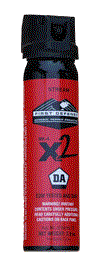Chemical Agent Instructor
| Home | • | Contact | • | Tear Gas Resource |
Pepper Spray the New Intermediate Force?
Where does your non-lethal pepper spray (OC) fit into your use of force policies? If you haven’t reviewed this in the last six months you should be doing it right now. The United States Court of Appeals for the 9th Circuit has recently redefined for you when pepper spray (OC) can be used.
In the case of Mark Young v. The County of Los Angeles Mr. Young was stopped for a traffic violation. He presented  his requested documents and got out of his pick-up truck. The deputy (Wells) ordered Mr. Young back into his truck and Mr. Young refused. He sat down on the curb and started eating vegetables from a bag. The deputy walked up behind the suspect and sprayed him with OC. The deputy continued to pepper spray Young as he rose to his feet and attempted to back away from the pepper spray. Young protested, repeatedly telling the deputy, “I’m an officer of the law.” Young asserts that the deputy responded to his protests by drawing his baton, striking him a number of times with it, and ordering him to get on the ground. The suspect was arrested and placed in a patrol car when cover arrived.
his requested documents and got out of his pick-up truck. The deputy (Wells) ordered Mr. Young back into his truck and Mr. Young refused. He sat down on the curb and started eating vegetables from a bag. The deputy walked up behind the suspect and sprayed him with OC. The deputy continued to pepper spray Young as he rose to his feet and attempted to back away from the pepper spray. Young protested, repeatedly telling the deputy, “I’m an officer of the law.” Young asserts that the deputy responded to his protests by drawing his baton, striking him a number of times with it, and ordering him to get on the ground. The suspect was arrested and placed in a patrol car when cover arrived.
The Ninth Circuit has stated:
“Both pepper spray (OC) and baton blows are forms of force capable of inflicting significant pain and causing serious injury. As such, both are regarded as “intermediate force” that, while less severe than deadly force, nonetheless present a significant intrusion upon an individual’s liberty interests.
Pepper spray (OC) “is designed to cause intense pain,” and inflicts “a burning sensation that causes mucus to come out of the nose, an involuntary closing of the eyes, a gagging reflex, and temporary paralysis of the larynx,” as well as “disorientation, anxiety, and panic.”
In pepper spraying Young and striking at him multiple times with a baton while landing at least two blows, Wells used a significant amount of two forms of intermediate force known to cause serious pain and to lead in some cases to serious physiological consequences. Whatever such force is ultimately labeled, there is no question that its use against an individual is a sufficiently serious intrusion upon liberty that it must be justified by a commensurately serious state interest.
Our conclusion (9th Circuit) comports with the logical notion that it is rarely necessary, if ever, for a police officer to employ substantial force without warning against an individual who is suspected only of minor offenses, is not resisting arrest, and, most important, does not pose any apparent threat to officer or public safety. Indeed, we have found the use of pepper spray (OC) to be excessive in such circumstances even when a warning was provided. Headwaters Forest Defense v. County of Humboldt, 276 F.3d 1125, 1129-30 (9th Cir. 2002)”
Click here for the full opinion
There can be many interpretations of this ruling. However, the court is clear in stating that they believe pepper spray is an intermediate force option. In their conclusion they state that if a suspect in not resisting arrest, is engaging in a minor offense and does not pose any apparent threat to you or the public’s safety the use of your pepper spray (OC) is excessive.
The case of Headwaters Forest Defense v. The County of Humboldt was a case where Sheriff’s deputies used pepper spray (OC) on protesters in an attempt to get them to release their locked arms out of metal sleeves that formed an unbroken circle. The same court in that case ruled that pepper spray (OC) should not be used on non-violent protesters as a means of pain compliance. The case was exacerbated by worldwide television coverage of a deputy applying OC to a protester with a Q-tip.
You would be wise to have your department’s legal representative review your policy along with this case and perhaps issue a training bulletin based on the ruling. The training bulletin should address how and when will you use your pepper spray (OC) in the future?
Back
If you have any questions please go to the contacts page and contact Dennis Cole.